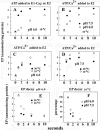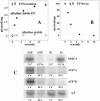Distinctive features of catalytic and transport mechanisms in mammalian sarco-endoplasmic reticulum Ca2+ ATPase (SERCA) and Cu+ (ATP7A/B) ATPases
- PMID: 22854969
- PMCID: PMC3463298
- DOI: 10.1074/jbc.M112.373472
Distinctive features of catalytic and transport mechanisms in mammalian sarco-endoplasmic reticulum Ca2+ ATPase (SERCA) and Cu+ (ATP7A/B) ATPases
Abstract
Ca(2+) (sarco-endoplasmic reticulum Ca(2+) ATPase (SERCA)) and Cu(+) (ATP7A/B) ATPases utilize ATP through formation of a phosphoenzyme intermediate (E-P) whereby phosphorylation potential affects affinity and orientation of bound cation. SERCA E-P formation is rate-limited by enzyme activation by Ca(2+), demonstrated by the addition of ATP and Ca(2+) to SERCA deprived of Ca(2+) (E2) as compared with ATP to Ca(2+)-activated enzyme (E1·2Ca(2+)). Activation by Ca(2+) is slower at low pH (2H(+)·E2 to E1·2Ca(2+)) and little sensitive to temperature-dependent activation energy. On the other hand, subsequent (forward or reverse) phosphoenzyme processing is sensitive to activation energy, which relieves conformational constraints limiting Ca(2+) translocation. A "H(+)-gated pathway," demonstrated by experiments on pH variations, charge transfer, and Glu-309 mutation allows luminal Ca(2+) release by H(+)/Ca(2+) exchange. As compared with SERCA, initial utilization of ATP by ATP7A/B is much slower and highly sensitive to temperature-dependent activation energy, suggesting conformational constraints of the headpiece domains. Contrary to SERCA, ATP7B phosphoenzyme cleavage shows much lower temperature dependence than EP formation. ATP-dependent charge transfer in ATP7A and -B is observed, with no variation of net charge upon pH changes and no evidence of Cu(+)/H(+) exchange. As opposed to SERCA after Ca(2+) chelation, ATP7A/B does not undergo reverse phosphorylation with P(i) after copper chelation unless a large N-metal binding extension segment is deleted. This is attributed to the inactivating interaction of the copper-deprived N-metal binding extension with the headpiece domains. We conclude that in addition to common (P-type) phosphoenzyme intermediate formation, SERCA and ATP7A/B possess distinctive features of catalytic and transport mechanisms.
Figures










Similar articles
-
Mechanisms of charge transfer in human copper ATPases ATP7A and ATP7B.IUBMB Life. 2017 Apr;69(4):218-225. doi: 10.1002/iub.1603. Epub 2017 Feb 5. IUBMB Life. 2017. PMID: 28164426 Review.
-
Comparative features of copper ATPases ATP7A and ATP7B heterologously expressed in COS-1 cells.Biochemistry. 2010 Nov 23;49(46):10006-12. doi: 10.1021/bi101423j. Epub 2010 Oct 27. Biochemistry. 2010. PMID: 20964302 Free PMC article.
-
Biochemical characterization of P-type copper ATPases.Biochem J. 2014 Oct 15;463(2):167-76. doi: 10.1042/BJ20140741. Biochem J. 2014. PMID: 25242165 Free PMC article. Review.
-
Effects of high-affinity inhibitors on partial reactions, charge movements, and conformational States of the Ca2+ transport ATPase (sarco-endoplasmic reticulum Ca2+ ATPase).Mol Pharmacol. 2008 Apr;73(4):1134-40. doi: 10.1124/mol.107.043745. Epub 2008 Jan 22. Mol Pharmacol. 2008. PMID: 18212248 Free PMC article.
-
Interference with phosphoenzyme isomerization and inhibition of the sarco-endoplasmic reticulum Ca2+ ATPase by 1,3-dibromo-2,4,6-tris(methylisothiouronium) benzene.J Biol Chem. 2005 May 6;280(18):17579-83. doi: 10.1074/jbc.M500472200. Epub 2005 Mar 3. J Biol Chem. 2005. PMID: 15746094
Cited by
-
A case of a mild Wolfram Syndrome with concomitant ATP7B mutation.CellR4 Repair Replace Regen Reprogram. 2019;7:e2735. doi: 10.32113/cellr4_20198_2735. Epub 2019 Aug 28. CellR4 Repair Replace Regen Reprogram. 2019. PMID: 33869661 Free PMC article.
-
Modulating Chemosensitivity of Tumors to Platinum-Based Antitumor Drugs by Transcriptional Regulation of Copper Homeostasis.Int J Mol Sci. 2018 May 16;19(5):1486. doi: 10.3390/ijms19051486. Int J Mol Sci. 2018. PMID: 29772714 Free PMC article. Review.
-
Preexisting domain motions underlie protonation-dependent structural transitions of the P-type Ca2+-ATPase.Phys Chem Chem Phys. 2017 Apr 12;19(15):10153-10162. doi: 10.1039/c7cp00243b. Phys Chem Chem Phys. 2017. PMID: 28374038 Free PMC article.
-
Characterization of ATP7A missense mutants suggests a correlation between intracellular trafficking and severity of Menkes disease.Sci Rep. 2017 Apr 7;7(1):757. doi: 10.1038/s41598-017-00618-6. Sci Rep. 2017. PMID: 28389643 Free PMC article.
-
Enhanced cellulase production by decreasing intercellular pH through H+-ATPase gene deletion in Trichoderma reesei RUT-C30.Biotechnol Biofuels. 2019 Aug 13;12:195. doi: 10.1186/s13068-019-1536-2. eCollection 2019. Biotechnol Biofuels. 2019. PMID: 31417630 Free PMC article.
References
-
- Albers R. W. (1967) Biochemical aspects of active transport. Annu. Rev. Biochem. 36, 727–756 - PubMed
-
- de Meis L., Vianna A. L. (1979) Energy interconversion by the Ca2+-dependent ATPase of the sarcoplasmic reticulum. Annu. Rev. Biochem. 48, 275–292 - PubMed
-
- Post R. L., Hegyvary C., Kume S. (1972) Activation by adenosine triphosphate in the phosphorylation kinetics of sodium and potassium ion transport adenosine triphosphatase. J. Biol. Chem. 247, 6530–6540 - PubMed
-
- Brini M., Carafoli E. (2009) Calcium pumps in health and disease. Physiol. Rev. 89, 1341–1378 - PubMed
-
- MacLennan D. H., Brandl C. J., Korczak B., Green N. M. (1985) Amino-acid sequence of a Ca2+ + Mg2+-dependent ATPase from rabbit muscle sarcoplasmic reticulum, deduced from its complementary DNA sequence. Nature 316, 696–700 - PubMed
Publication types
MeSH terms
Substances
Grants and funding
LinkOut - more resources
Full Text Sources
Research Materials
Miscellaneous

